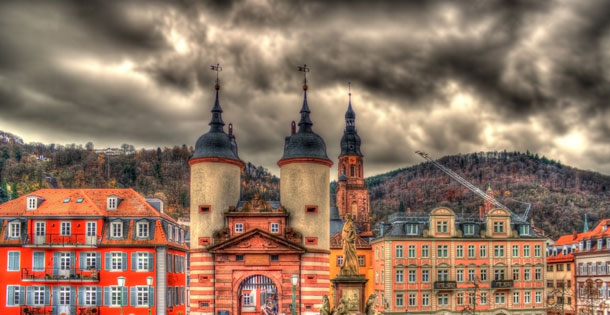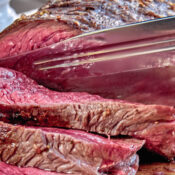It was midnight, and silent. Mannheim had not known a silent midnight in two years. Skulking in the bushes beyond the ruins of the Rathaus, Renata bid her time. The lights inside the American Military government headquarters were out; the moonless sky was black. Seizing the moment, Renata dashed across the grounds and tore up the flowerbed …
A jeep carrying two GIs roared up in front of the apartment that Chaplain Rabbi Haselkorn had requisitioned for three Polish Jews who had passed on false papers. A young man and two young women; one, still in her teens, had been brought to him six weeks before by a Jewish GI. Foraging for food, the younger girl had been caught in last-minute crossfire. Crouching for cover in the rubble of a gutted home, she had overheard a soldier trying to communicate with a German civilian in a guttural language, which she knew was not German. She waited for the GI to finish speaking. She skirted around the scraps of metal and loose bricks that littered the devastated streets, and ran after him.
“Jude!” She shouted. The soldier bristled “What?”
“Jude!” Renata insisted, pointing at him. The soldier glowered. “Who the hell are you?!”
“Jude! Ich bin Jude,” Renata pleaded, first, in desperation, and then with a resurfacing sense of hope.
“Oh, Jesus!” Finally, light had dawned. “You …?”
“Ja! Jude! Jude! Ich bin Jude!” Renata beamed, fervently shaking her head.
“Oh, Christ!” The Jewish GI gasped in recognition.
“Kommen.” Renata led the overwhelmed soldier to a cylinder along the riverbank in which two people huddled together. Slave laborers were denied access to German bomb shelters. Her friends Cesia and Shimon cowered inside. Renata spoke to them in Polish and gently coaxed them out.
The GI brought the three young people to the American Military government headquarters, to Chaplain Rabbi Haselkorn, who promptly ejected a German couple from a nearby apartment, and bequeathed the space to Cesia, Shimon, and Renata. Now they were standing at the apartment entrance.
“Hi!” The driver winked. “You guys ready?”
Cesia, Shimon, and Renata glanced at each other. Cesia wore a dress, and Shimon, a suit that Renata had “requisitioned” from the closet of the departing German couple. Renata wore a dyed white coat over her own dress, which she had converted from a khaki-colored American army blanket. Designated the group’s spokesman, Renata stepped up and responded, “Och Kay! Ve ready!”
“Well, hop in!” The driver thumbed towards the back of the jeep. Renata turned to her companions, showing off her constantly expanding English vocabulary. “Okie Dokie. Let’s go!”
Carefully, Shimon lifted Cesia into the jeep. She was carrying his child. Renata followed, carrying the bouquet she had assembled from the contents of the flowerbed in front of the old Rathaus.
**
The GIs drove out of the city and onto the autobahn to Heidelberg. Heidelberg had been unharmed on orders from General Eisenhower because he planned to install his headquarters there. Jewish GIs had stumbled upon a tiny synagogue in a narrow lane in Old Heidelberg that, curiously, was still standing. The jeep clattered over the cobblestones of the ancient town, and rode up to it. Inside, a buffet table was heaped with doughnuts and cold cuts and pretzels and jelly beans and Wrigley’s chewing gum and O’Henry chocolate bars, and wine, and beer, and ginger ale and Coca-Cola, and Florida oranges the size of sunsets. The GIs had obtained the food in much the same manner as Renata had obtained the bouquet.
Renata and her companions gaped. They had not seen such a feast in six years. “Take a load off. Relax!” While the soldiers added final touches to the table, Renata and her companions sat on the synagogue steps and waited. An hour later, a canvas truck, flanked by a jeep, rumbled up the road. Chaplain Rabbi Haselkorn, accompanied by a pair of United Nations Relief and Rehabilitation Administration workers, leapt out and pulled the canvas aside. Wraith-like apparitions began to stir. The UNNRA workers stretched out their arms, and skeletal hands latched onto them. Laboriously these specters limped off the truck, their steps tentative, unsteady, like pencils attempting to walk. They’d been liberated from their striped camp uniforms, deloused, scraped clean, and then dressed in an assortment of ill-fitting and mismatched clothes. One by one, the figures filed off the back of the truck. There were 30 of them, all men. They were confronted by a shy, young couple, almost as emaciated as they were, and a grinning teenager cradling a long-stemmed bouquet in her arms. She was robust and rosy cheeked, having already benefited by Seventh Army largesse. Instinctively, the silhouettes knew.
“Amchu?” they whispered, to the couple and the girl.
“Amchu,” the three affirmed.
One of us …
There were still Jews in the world. There were still Jewish women. Their own women had been wrenched from them at the first selection. Was there a wife or a sister who had been spared? Were such miracles possible? How?
Chaplain Rabbi Haselkorn led the congregation into the synagogue. Shimon and Cesia were pronounced man and wife.
**
After the ceremony, the congregation gathered around the buffet table. The bridal couple, the maid of honor, and the guests, in a daze, exchanged tales of survival. Tears, dammed for years, flowed like champagne. The men were Polish Jews from a town called Radom. They had been deported together and had survived, together. Five weeks earlier they had been liberated at Vaihingen by the French. They had been placed in a village near Neuenberg, and were beginning to recover. However, the French commander in charge of the village had received orders to transfer them to a Polish displaced persons camp, and he was concerned about the treatment Jewish survivors were likely to receive there. He had approached Chaplain Rabbi Haselkorn, who approached a Jewish lieutenant from Chicago, who succeeded in having the Radomer Jews transferred to the American zone because his superior looked away.
The Radomer Jews were currently housed in an ancient castle down the road. The lieutenant had evicted squatting Germans, Ukrainians, and Latvians, had the castle cleaned, and the Radomer Jews moved into Schloss Langenzell. Now they were attending a wedding reception. Only those capable of digesting solids, and strong enough to stand, had been invited to the wedding. The flesh of oranges, peeled by trembling fingers, erupted like sunbursts. Doughnuts, sprinkled with real sugar, sparkled like jewels on reverently held paper plates. The men shuffled, with their treasures, to the wooden benches in the center of the room. One of their number, a young man called Kaddish, moved to the front, to where the bimah had once been. Without prompting, without accompaniment, he sang Kol Nidre:
All personal vows we are likely to make, all personal oaths and pledges we are likely to take between this Yom Kippur and the next Yom Kippur, we publicly renounce. Let them all be relinquished and abandoned, null and void, neither firm nor established. Let our personal vows, pledges and oaths be considered neither vows nor pledges nor oaths.
As Kaddish’s clear tenor filled the hall, the gathering grew hushed. Heads were bent in contemplation; shoulders were stooped in sorrow. Kaddish concluded the prayer. Palms plunged into eye sockets as if, by so doing, they could press out memory.
Slowly the congregation rose and moved outside, into the courtyard. The sky was silver. The stones glistened. It was drizzling. A UNNRA worker pulled out a Leica camera. “Okay, gang. One for the album.” The congregation arranged itself into three rows: Shimon and Cesia in the middle, with Chaplain Rabbi Haselkorn standing next to the bride. The front row was kneeling. Renata perched on a soldier’s lap. Kaddish sat on the damp earth, next to her. Renata would meet him again, in Canada, at her own wedding. He would become her brother-in-law. The UNNRA worker aimed the lens. “Come on everybody. SMILE.”
The group gazed into the May mist. Beyond their vision lay a maze of roofs caught between the river and the hills. They stared out from this fairytale town, nestled within a gorge, untouched by horror, atrocity, or even time. The mountains hung on the horizon, and a train chugged along the banks of the Neckar: the trains … the trains …
The group stared into an open future and, bravely, smiled.
Become a Saturday Evening Post member and enjoy unlimited access. Subscribe now




Comments
Wonderfully written! So solemn yet grateful. Thank you
A very beautiful story, clearly rooted in a real event. Makes one think not only about the devastation and horror of Europe in 1945,but of the strange encounter of the arriving American soldiers.
“A Wedding in Heidelberg” is a powerful depiction of “the pull of life'” after the most horrific suffering and experiences. The writing in this story reveals a deeply sympathetic understanding of the characters and the remarkable circumstances in which they find themselves. The incredulity of the guests and the combination of their celebrating most likely the first Jewish wedding in Germany after the Holocaust while mourning the dead is so poignantly drawn. Both their tragic fragility and the extraordinary kindness and caring of the American soldiers and the rabbi in this story are worthy of remembrance.
S. Nadja Zajdman is a very talented writer whose insightful character depiction, vivd description and imagery and development of plot allow her stories to touch the heart. “A Wedding in Heidelberg” allows readers to experience both catharsis and hope.
Outstanding!